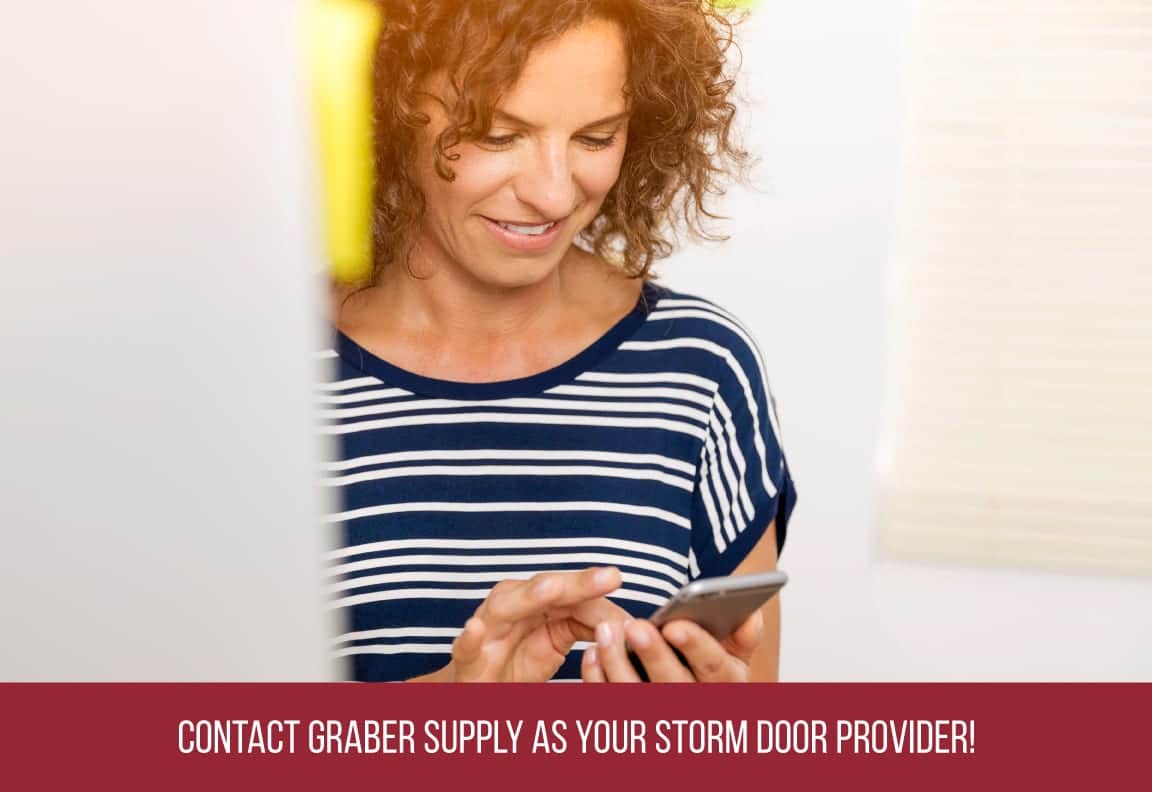Home Storm Doors: The Ultimate Guide [including their 6 main benefits]
There's nothing like the simple joy of basking in the warm sunshine while a light breeze tosses your hair.
So why don't more people open their front doors, letting in sunlight and fresh air?
There are several reasons.
Maybe you don't want to let the bugs in, or you're afraid of a pet or child toddling outside. Or, maybe, you don't want to open your door to any stranger on the street.
Whether your objection is security or bugs, it could be solved with a quality storm door. And at Graber Supply, we're convinced that a storm door can also increase your quality of life and boost your home value. After all, we've experienced it firsthand!
Want to find out how?
Let's get started!
What Is A Storm Door?
A storm door is a second door installed on the outside of your entry door. It's designed to protect against bad weather and provide ventilation and light during beautiful weather.
Most storm doors are equipped with interchangeable or retractable glass and screen panels.
In appearance and function, a storm door acts more like a screen door than an entry door.
Storm Doors vs. Screen Doors
While a storm door appears much like a screen door, they are not the same.
Screen doors are exactly what they sound like: doors with screens.
Screen door frames can be made of various materials, but the most common types of screen doors have wooden frames and very few components. They protect from pests and bugs while continuously letting in fresh air and light.
Storm doors have a few more parts and pieces to them. The most significant difference between storm doors and screen doors is that storm doors have glass panels instead of just screens.
The glass panel comes in various sizes depending on the storm door style. Usually, the glass panels can slide up and down or be removed entirely so you can directly control the airflow into your home.
However, when you close the glass panels, you have an extra layer of protection and security in your entryway.
Plus, the glass panels prove to be helpful in cold weather as well as warmer temperatures.
Most storm doors also feature a latching or locking handle set that enhances security. And the most innovative storm doors include features like retractable screens, KeepSafe glass, and concealed closers.
While both screen and storm doors provide protection, storm doors are the more robust option.
The Purpose Of A Storm Door
A storm door has two primary purposes:
- When the weather is nice, a storm door allows you to open your entry door and allow additional light into your home while keeping intruders like dust and bugs are kept at a minimum
- During inclement weather, a storm door protects your expensive entry door from rain, ice, and snow. It also creates an extra insulation layer to stay cozy and cut utility costs.
While these are the biggest reasons to install a storm door, there are plenty of other benefits too. More on that later!
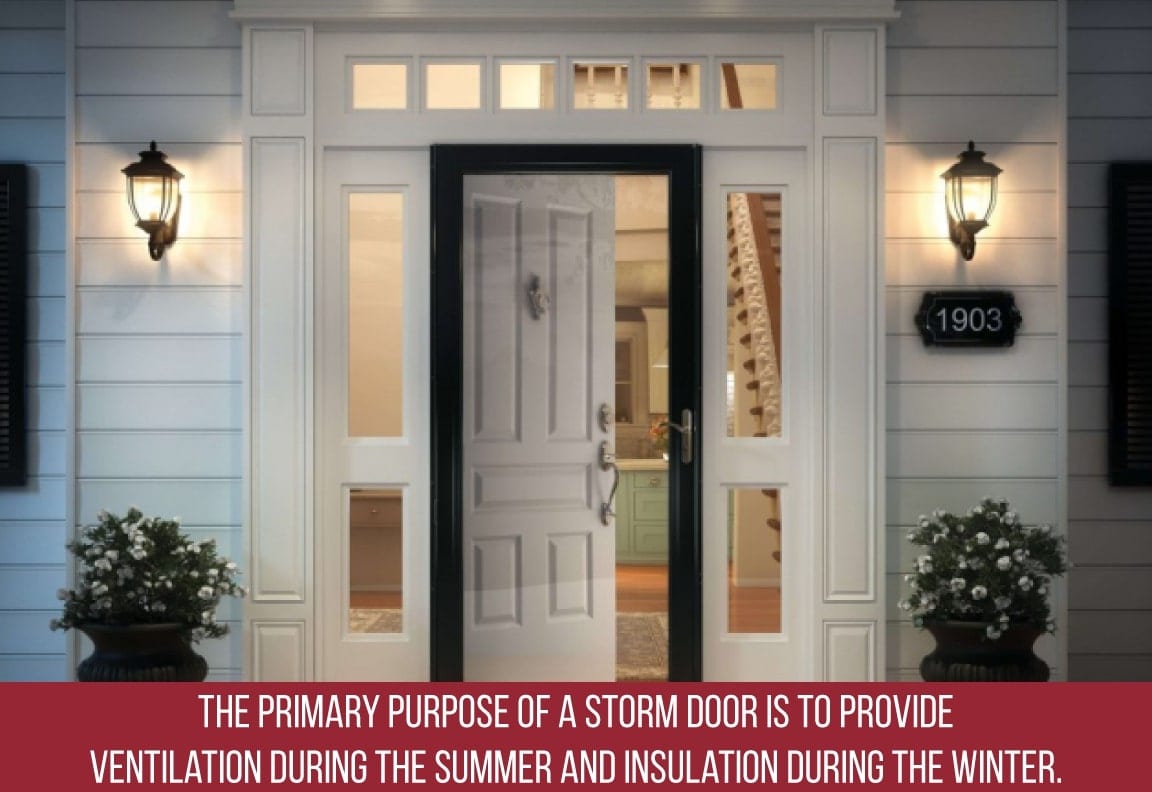
Components Of A Storm Door
As you might expect, storm doors come in a variety of styles. However, all storm doors are made from the same essential components.
You can break them down like this:
- Exterior materials
- Glass and screens
- Insulation
- Hardware
Now, let’s look at each of these four components.
Exterior Materials For A Storm Door
A storm door's exterior materials cover the insulation and create a sort of protective skin. As a bonus, these materials can also be made aesthetically pleasing!
The three most common materials used for the exterior of a storm door are wood, aluminum, and vinyl.
Wooden storm doors can look beautiful. Some people say they look as good as their entry door.
However, wood absorbs humidity over time. As a result, the frame can begin to curve and lose shape, especially if exposed to intense sunlight. Wood storm doors also require more maintenance than some other types.
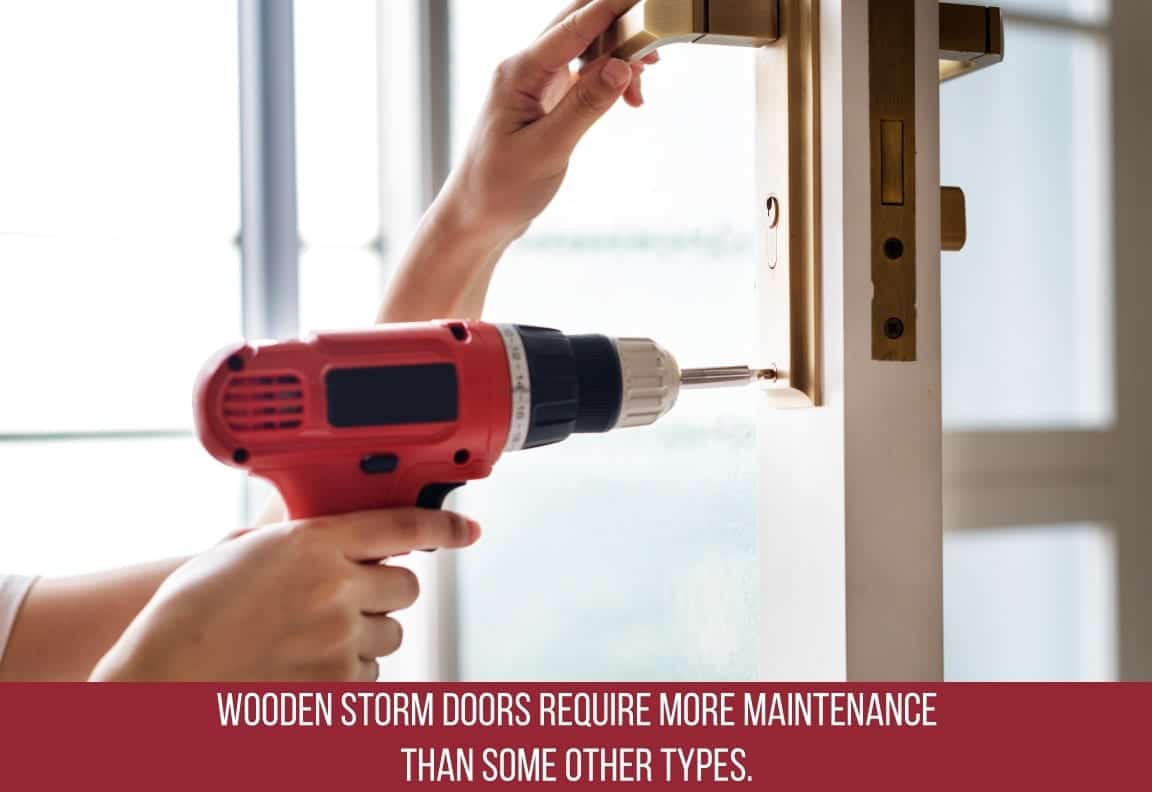
Aluminum storm doors are thicker and more rigid than wood. Aluminum doors are also sold in various degrees of thickness—the thicker the aluminum, the sturdier the door is.
Aluminum doesn't corrode, so you won't have to paint your door often. In fact, aluminum has recently been the top material for storm doors.
Vinyl or PVC storm doors allow the manufacturer to create a door frame that looks like wood but requires less maintenance.
It is also possible to shape it in a desirable pattern, which will enhance the exterior of your home. This storm door is long-lasting since the PVC frame won't bend, crack, or corrode.
If a higher price tag isn't an issue for you, this could be an excellent option.
Glass And Screens For Storm Doors
As mentioned, storm doors primarily comprise glass panels and screens. While this is a common denominator in storm doors, you can find different types of glass and screens, some of which you may prefer.
Standard, non-decorative glass panels are the simplest and cheapest option available.
You can also choose a beveled glass storm door.
You're probably accustomed to seeing the feature on mirrors, but you can also use beveled glass for windows, tabletops, and doors.
The style has tapered edges that accentuate the frame and give the piece an old-world elegance.
Another cool feature of beveled glass is that it creates a prism that refracts light and makes alluring color patterns. When light hits it, it sparkles and shimmers, adding a bit of pizzazz to any storm door.
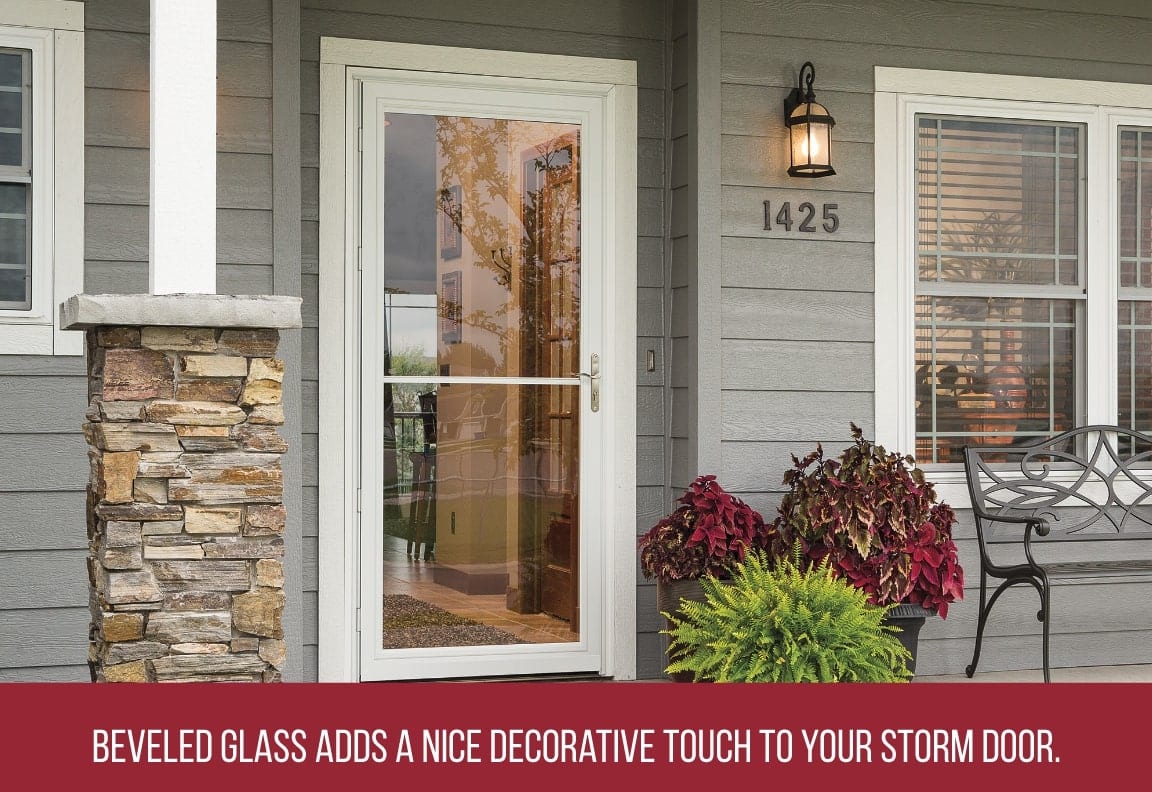
A third option is installing a low emissive (Low-E) glass storm door.
Low-E glass has a microscopically thin, transparent coating that reflects heat. That means you provide better insulation for your home and reduce fading on your entry door.
But sometimes the heat that gets trapped between the Low-E storm door and entry door can cause several problems, including:
- Warping the glass trim on the entry door
- Warping or bowing the entire entry door
- Freezing of the storm door when winter cold causes condensation to form as the cold air hits trapped hot air.
To prevent these issues, it's important to have proper ventilation of your storm door so trapped hot air is released.
For this reason, we encourage homeowners to consider Low-E glass for their entry doors rather than storm doors.
When it comes to storm door screens, you have four primary options:
- Galvanized steel screens are the least expensive and resist holes and tears. Spray this type of screen with household lubricant once a year to prevent rust from forming.
- Aluminum screens resist corrosion (except in seaside areas) but aren't as strong as galvanized steel screens. In areas with heavy smog, aluminum tends to darken but can be protected with commercial spray products.
- Bronze screens are the most durable and the most expensive. Apply a thin coat of varnish every few years to protect the screen against corrosion.
- Fiberglass screens resist corrosion and are easy to install, which makes them a practical replacement screen if a metal screen deteriorates.
Storm Door Insulation
Some storm doors come without insulation. These are called hollow core doors. They are cheaper than insulated storm doors, but if you've touched one during the winter, you know exactly how cold they can get!
Solid wood or dense foam both serve as excellent insulators for storm doors.
If you're trying to decide if a storm door is insulated, you have two simple options:
First, you can ask the place of business what insulation is used in the storm door.
You can also check to see what the U-value of the door is. If the storm door has a low U-value, you can know that it is probably insulated well.
Storm Door Hardware
Storm doors don't include much hardware, but knowing your options is valuable.
The first piece of hardware you'll need is some kind of handle or doorknob to open your storm door. While some screen doors have only a handle, we discourage that approach with storm doors. After all, a storm door is meant to protect your home, so you'll need a more robust fastening system.
We recommend buying knob hardware that comes with a reliable latch and lockset. This allows your storm door to be a second layer of protection against wind and intruders.
In particular, we suggest using mortise hardware. A mortise refers to the pocket cut into the door where the lock is fitted. Therefore, you cannot install a mortise lockset on just any door.
This can be a little inconvenient if you ever need to replace your lockset, but it is a very secure lock system that keeps your home safer.
Other pieces of hardware that come with a storm door include a door closer or doorstop.
Both devices control how far your door can open. A doorstop, also called a snubber, uses a chain attached to a spring to control the door. It's easy to install and adjust.
A pneumatic closer prevents a door from opening too fast or too far and also closes the door slowly and firmly. Most doors have one pneumatic closer, but some have two for extra protection against high winds.
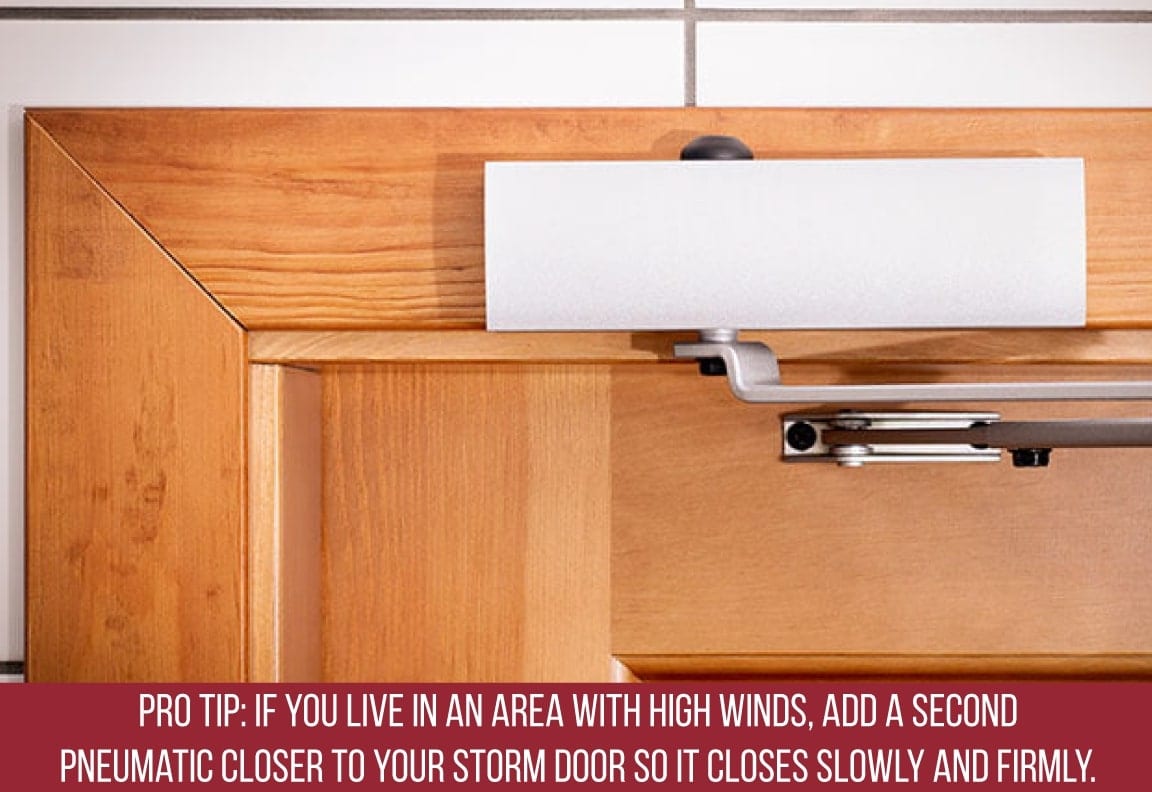
6 Benefits Of A Storm Door
Now that you know what a storm door is, plus a few features you might look for in one, it's time to move on to the benefits of a storm door.
After all, no one wants to waste their money on something that isn't a worthwhile investment!
Here are a few ways storm doors can add value to your home.
More Natural Light
A bright entryway is inviting, but without a storm door, entryways can end up dark and dreary.
Installing a storm door allows you to leave your front door open so natural light comes through the storm door and creates a bright and welcoming space.
Comfortable Living
When you heave a sigh and flop down on the couch after a long day at work, the last thing you want to feel is a cold draft!
A storm door minimizes the cold drafts you feel in your house by adding an extra layer of protection to your entryway.
And beyond temperature, storm doors improve the air quality in your home, prevent mold growth, and reduce the dust, dirt, and insects that get into your house.
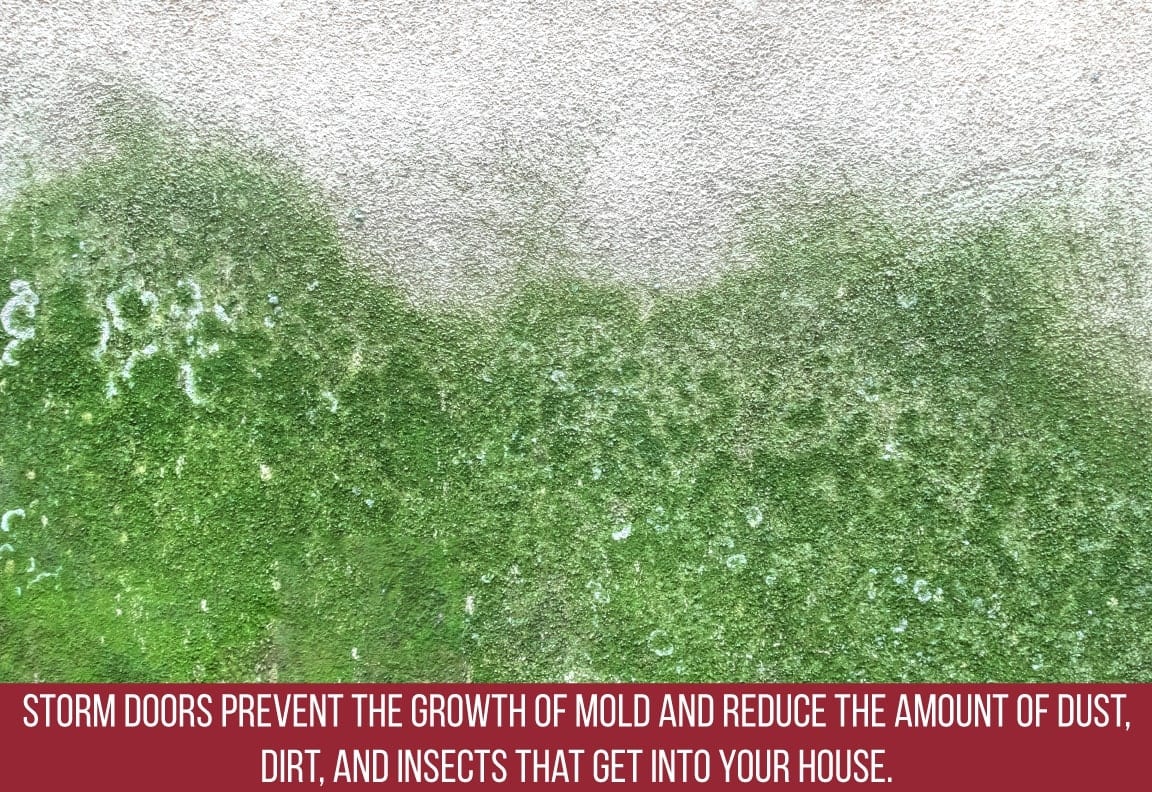
Less Entry Door Maintenance
Entry doors are expensive. In fact, an average homeowner spends $1,200 on installing an entry door.
If you are spending that much money on an investment, you want to ensure you protect and take care of it!
Thankfully, a storm door can help you do that. There may be no better way to shield your entry door from the elements than a quality storm door.
Improved Energy Efficiency
Yes, installing a storm door includes an upfront cost, but you reap the rewards of an efficient door for years to come!
Storm doors reduce heating costs in the winter and cooling costs in the summer. You save money every single month after you install your storm door.
Beyond that, some states offer incentives for installing energy-efficient doors and windows.
DSIRE is a comprehensive source of information on state, local, utility, and federal incentives and policies that promote renewable energy and energy efficiency. Simply choose your state to view the policies and incentives that apply to you.
You can also find rebates for windows, doors, and skylights using ENERGY STAR'S rebate finder.
And if you want to learn more about how energy-efficient doors and windows can change your life, you may want to read our blogs:
- Considering New Replacement Windows? Read Our Ultimate Guide To Windows First
- 9 Reasons A New Home Entry Door Is The Right Choice (and how to choose the right one!)
Enhance Curb Appeal And Offer A Warm Welcome
Homeowners often overlook this benefit, but it's pretty essential. The beauty of storm doors is that they create a more inviting entry for guests. Guests know you are home if the front door is open, and they can see inside. An open door is a welcoming, hospitable signal!
Because having a glass storm door allows you to keep the front door open, more natural light can fill your home. As a result, your entryway will be even brighter and more beautiful.
Live Securely And Enjoy Peace Of Mind
Perhaps the greatest gift a quality storm door can give you is peace of mind. After all, where can you feel safe if not in your own home?
Thankfully, a storm door adds an extra layer of security to your home so you can feel safe and secure.
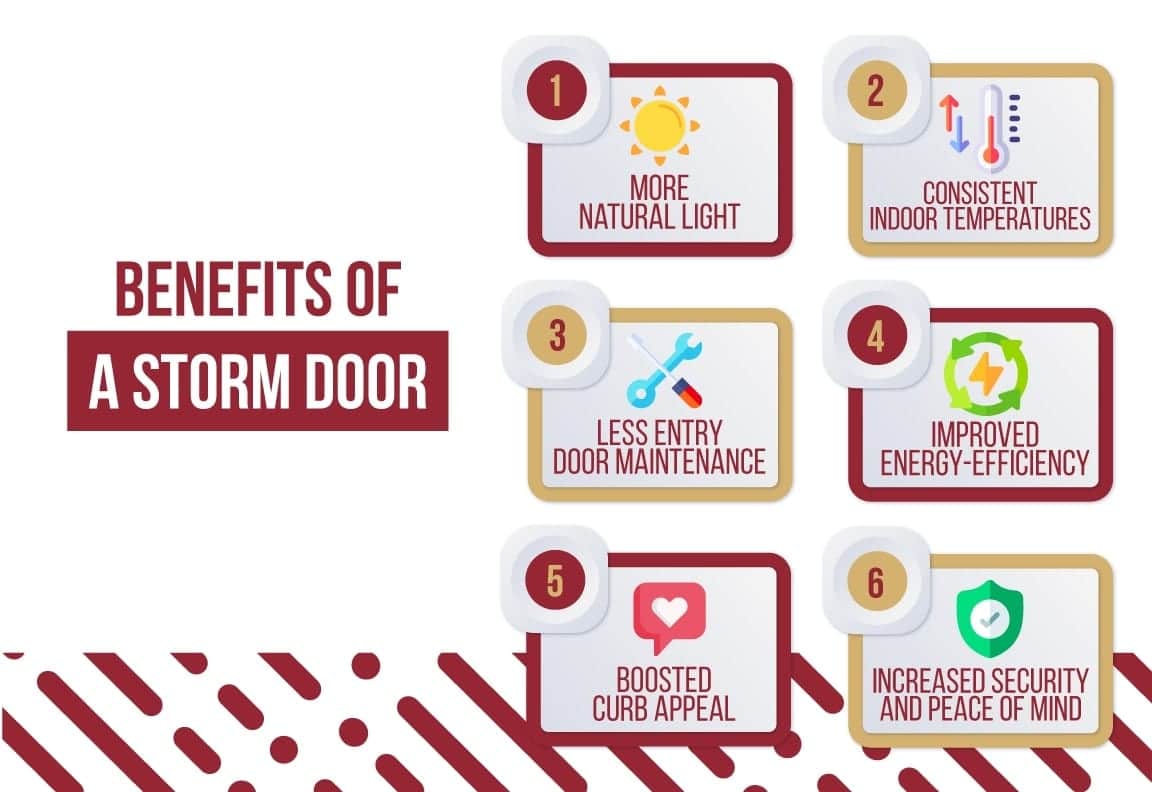
3 Cons Of A Storm Door
Of course, not every aspect of purchasing and installing a storm door is perfect.
You’ll want to remember a few things as you purchase a storm door.
Two Doors Can Be Inconvenient
When you come home with an armload of groceries or a car seat in tow, it can be frustrating to wrestle with two doors instead of one.
Thankfully, items like a One-Touch closer from Pella can hold your storm door open with the touch of a button.
Heat Build-Up
A storm door’s glass panels trap heat and can cause damage to a front door with prolonged sun exposure.
If your porch receives more than a few hours of direct sunlight daily, you should open the glass panels in the door.
Installation Required
Don’t you love it when you read the words, “Product comes assembled?”
Unfortunately, that’s not the case with storm doors. While the storm door itself does not need to be assembled, it does need to be installed—and this isn’t always an easy task for the casual DIYer.
It’s well worth the investment to hire a professional and get your storm door installed the right way the first time.
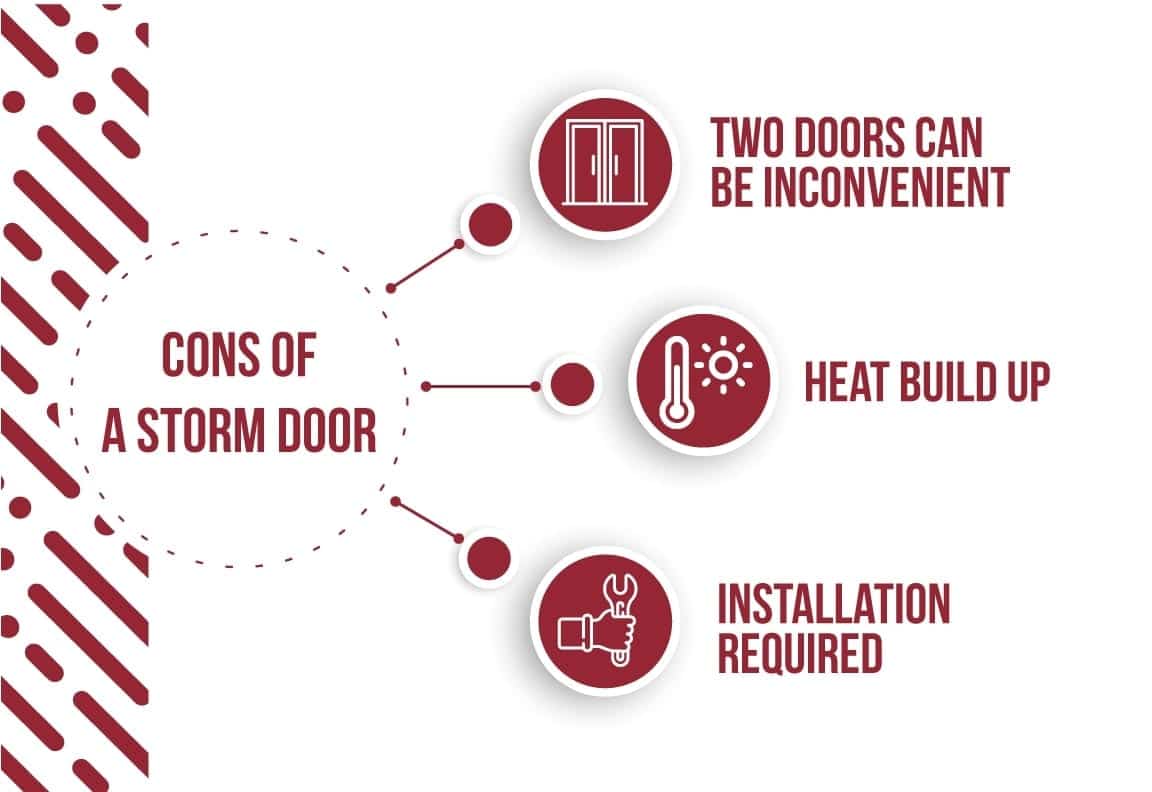
Styles Of Storm Doors
Once you've weighed the pros and cons of buying a storm door, it's time to decide which kind of door you want.
Thankfully, you have quite a few styles of storm doors to choose from!
Full-view storm door
With this door, you can expand your view and bring more light to your home. It has a full glass panel within the frame, which makes it practical and beautiful.
¾ Panel Storm Door
The glass panel in the upper half of a ¾ panel storm door is smaller, but it still occupies most of the door. The bottom part, made of solid material, makes the doors more stable. This kind of door is suitable if you open and close your door frequently.
½ Panel Storm Door
This model looks like a standard front door. The glass takes half of the door while the other part is made of solid material. The positive side of this type is that you can make it pet-friendly by creating a tiny entrance at the bottom for your furry friend.
You can also choose a storm door with retractable screens.
In the simplest form, retractable screens do just that: they retract. Retractable screens roll into a protective housing, becoming virtually invisible when unused.
Hopefully, one of these options is the attractive storm door you're looking for, which will be useful and beautiful!
And if you're looking for other efficient and attractive home upgrades, such as a new roof, you may be interested in reading our blog post about Decra roofing.
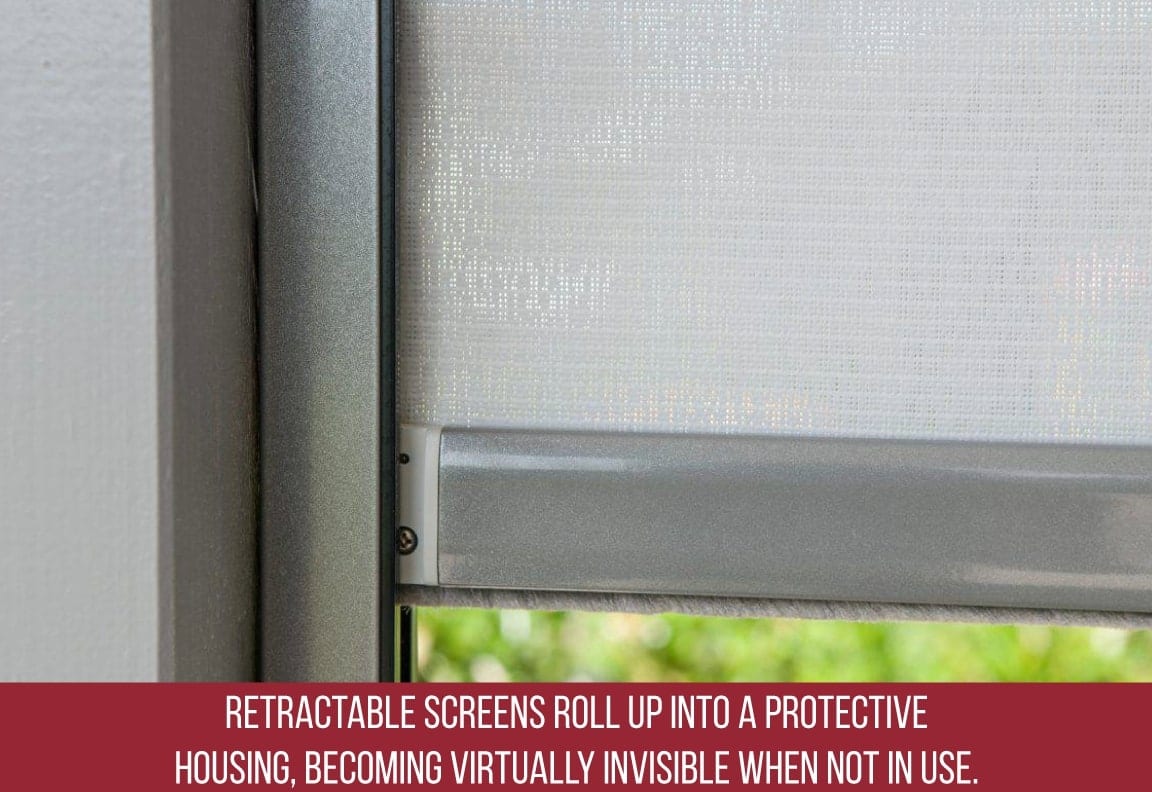
Conclusion
Storm doors check a lot of boxes for homeowners. Whether it’s ventilation, security, or insulation, a storm door is bound to increase the comfort of your home.
If you think your home would benefit from the addition of a storm door, consider contacting Graber Supply.
We are a home building supplier in Miami County, IN, and we offer quality storm doors as well as other products like:
The best part is that working with us couldn’t be easier! Follow this simple three-step process:
- Contact us to visit our showroom or schedule a consultation
- We’ll send you a customized quote for your review
- Use one of our experts to install your products
We look forward to hearing from you!
